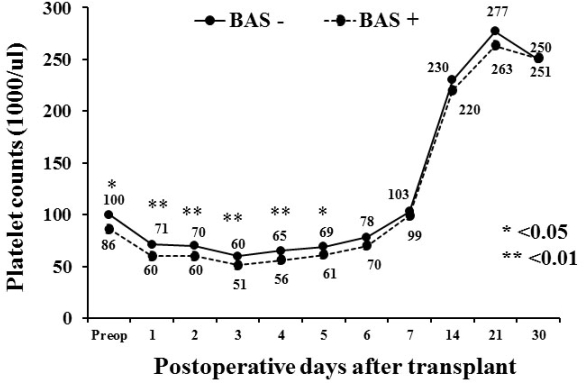Multifactorial Prediction of Biliary Stricture After Liver Transplantation: The Impact of Platelet Counts.
Transplant and Hepatobiliary Surgery, Henry Ford Hospital, Detroit, MI.
Meeting: 2016 American Transplant Congress
Abstract number: C207
Keywords: Bile duct, Liver transplantation, Outcome
Session Information
Session Name: Poster Session C: Liver Transplantation Complications and Other Considerations
Session Type: Poster Session
Date: Monday, June 13, 2016
Session Time: 6:00pm-7:00pm
 Presentation Time: 6:00pm-7:00pm
Presentation Time: 6:00pm-7:00pm
Location: Halls C&D
Background: Biliary stricture is a common cause of morbidity after liver transplantation (LT). This study aimed to determine the risk factors for post-transplantation biliary anastomotic strictures (BAS), focusing on perioperative platelet counts. Methods: We retrospectively reviewed all ABO-identical or compatible cadaveric LT and enrolled 771 consecutive recipients who underwent LT with duct-to-duct biliary reconstruction from January 2000 to June 2012. Recipients who received donation from after cardiac death donors were excluded. Results: BAS was reported in 142 cases (18.4%). The mean time for stricture development was 176.3 days. Postoperative platelet counts after LT were highly correlated with preoperative platelet counts. Preoperative and postoperative platelet counts within 5 days after LT were significantly lower in the patients with BAS than those without BAS  . Using the cutoff values acquired by receiver operating curve analysis, univariate analysis revealed that recipient age, recipient male gender, the Model for End-Stage Liver Disease (MELD) score >30, preoperative INR, and preoperative platelet count <76.500/[mu]l were risk factors for stricture development. No associations were observed in terms of donor and surgical factors. Multivariate analysis indicated that recipient age (odds ratio (OR) =1.03), recipient male gender (OR =1.65), the MELD score >30 (OR =2.00), and preoperative platelet count <76.500/[mu]l (OR =1.60) were independent risk factors. Conclusion:We demonstrated for the first time that low platelet count was associated with progression of BAS after LT. Increasing preoperative platelet count and maintaining platelet counts higher by platelet therapy such as thrombopoietin-receptor agonist administration could potentially reduce post-transplantation BAS.
. Using the cutoff values acquired by receiver operating curve analysis, univariate analysis revealed that recipient age, recipient male gender, the Model for End-Stage Liver Disease (MELD) score >30, preoperative INR, and preoperative platelet count <76.500/[mu]l were risk factors for stricture development. No associations were observed in terms of donor and surgical factors. Multivariate analysis indicated that recipient age (odds ratio (OR) =1.03), recipient male gender (OR =1.65), the MELD score >30 (OR =2.00), and preoperative platelet count <76.500/[mu]l (OR =1.60) were independent risk factors. Conclusion:We demonstrated for the first time that low platelet count was associated with progression of BAS after LT. Increasing preoperative platelet count and maintaining platelet counts higher by platelet therapy such as thrombopoietin-receptor agonist administration could potentially reduce post-transplantation BAS.
CITATION INFORMATION: Takahashi K, Putchakayala K, Rizzari M, Collins K, Nagai S, Yoshida A, Abouljoud M, Schnickel G. Multifactorial Prediction of Biliary Stricture After Liver Transplantation: The Impact of Platelet Counts. Am J Transplant. 2016;16 (suppl 3).
To cite this abstract in AMA style:
Takahashi K, Putchakayala K, Rizzari M, Collins K, Nagai S, Yoshida A, Abouljoud M, Schnickel G. Multifactorial Prediction of Biliary Stricture After Liver Transplantation: The Impact of Platelet Counts. [abstract]. Am J Transplant. 2016; 16 (suppl 3). https://atcmeetingabstracts.com/abstract/multifactorial-prediction-of-biliary-stricture-after-liver-transplantation-the-impact-of-platelet-counts/. Accessed December 25, 2025.« Back to 2016 American Transplant Congress
